So you have a good amount of traffic coming to your website, positive feedback on your content, and established a strong brand identity and persona.
It’s time to earn some money from all your hard work. It’s time to monetize your website!
One of the most popular options for blog monetization is Google AdSense. In this article, I’m going to show you how to easily install AdSense on WordPress with an awesome, free plugin.
Let’s Get Started
You need two things to start:
- Self-hosted WordPress website with enough traffic (Related: 5 Reasons to Move to Self-Hosted WordPress)
- A Google AdSense account
Sign up for an AdSense Account
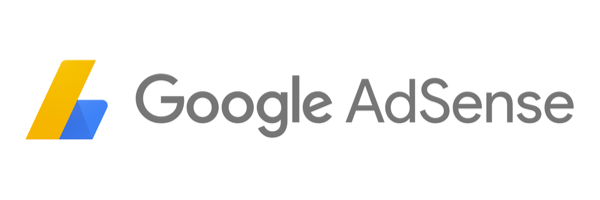
Skip this section if you already have one
Getting a Google AdSense account is as simple as applying through this link, clicking the Sign up now button and following the steps shown onscreen.
It’s important to note here that not all applications will be approved. Your website needs to satisfy all of Google AdSense’s requirements before it can display any ads. You must also abide by their guidelines. This is our oversimplified version to find out your website’s eligibility:
- You must be over 18 years old
- Your website must have good UX and have quality content
- Your website must not contain pornography, pirated or violent content, illegal products and services and sales of weapons, drugs and tobacco
- Your website is free from paid traffic.
We recommend you to take 5 minutes to read the AdSense Program Policies page. Google can be very strict with this, and you never want your application rejected or your account suspended for breaking the rules.
Please note that it can take 1-2 days to get your AdSense account approved.
How to Install AdSense on WordPress
Once you have Google AdSense, you can add it to your website straight away. The easiest method to do this is to install an AdSense plugin for WordPress platform. The harder way is to manually add the ad codes in your website’s html page.
Not all ad plugins are created equal. Some of them work best for people with coding or technical backgrounds, while others are plain confusing. Having used a few, I can recommend the Advanced Ads plugin. It has good features and is beginner-friendly. Best of all, you don’t have to do any coding or insert any <> anywhere!
Advanced Ads comes with both free and Pro versions. If you are short on cash, use the free version. If you have enough to spare, consider getting the advanced version – spending $1 to get $10 is money well spent.
To get Advanced Ads, go to Add Plugins and search for it. This will install the basic (free) version of the plugin.
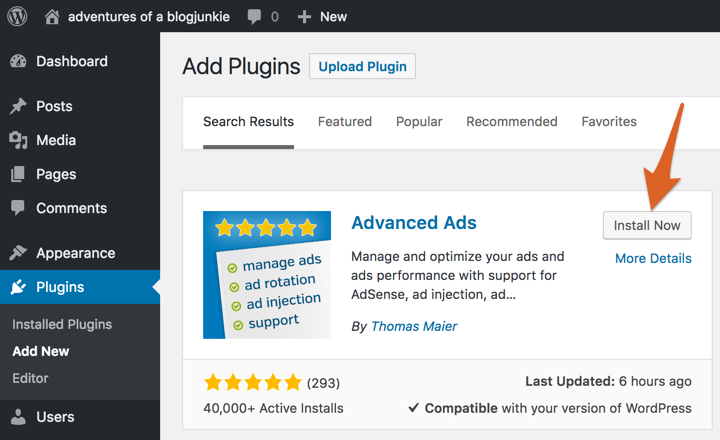
Install and activate the plugin. Advanced Ads will appear in the lefthand navigation. Click on it and you’ll arrive at the Ads Dashboard.
Connect to Google AdSense
Now we can connect your website to AdSense.
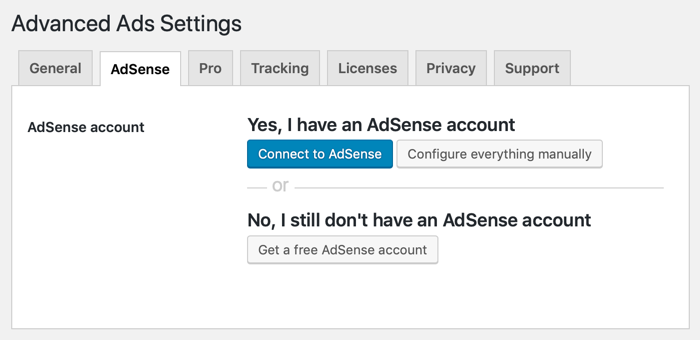
Navigate to Advanced Ads → Settings → AdSense. Click the Connect to AdSense button. A new window appears prompting you to sign in to your Google Account and then to allow Advanced Ads to access your account.
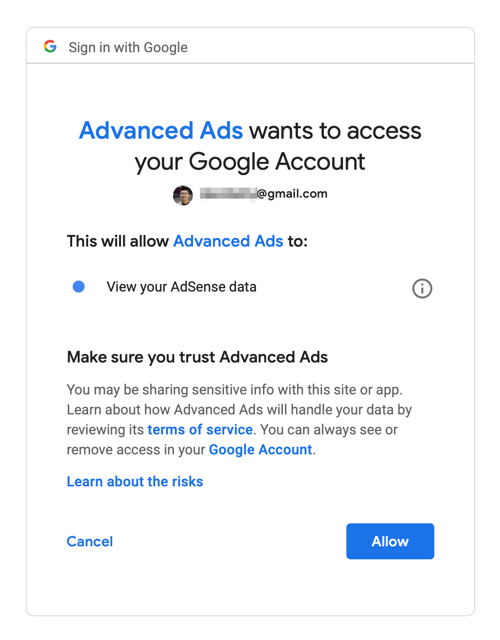
Click Allow. You’ll be shown some code to copy and paste.
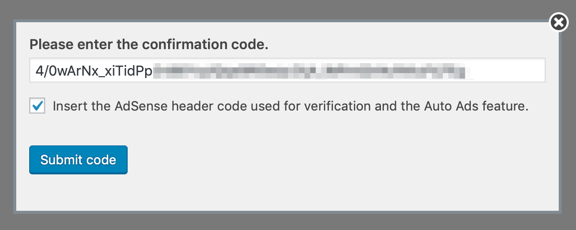
Paste the code into Advanced Ads. Be sure to select the checkbox, then click Submit code.
Finally, go back to AdSense Connect your site page and click Done. Once AdSense verifies the code, ads will begin to appear on your site. Google will analyze your site and find suitable ad placements, then automatically place the ads for you. It really can’t get simpler than that!
Control Where Ads Appear On Your Website
But perhaps you want to choose where exactly ads appear on your website. Advanced Ads makes this a code-free process too.
Navigate to Advanced Ads → Ads → New Ad. This will launch the Ad Wizard to guide you through creating a new ad. (If the Wizard is not active, click the Start Wizard button.)
I really like the Wizard with the clear, step-by-step instructions. He’s a bit soulless, but he gets the job done. Throughout the Wizard there are links to the manual and video tutorials to explain the options.
Name your project (e.g. Content Top) and hit next. Under Ad Type, choose Google AdSense and hit next. This brings you to the Ad Parameters step. You’ll need to copy and paste the AdSense ad code into the provided space.
Go to the AdSense dashboard → My Ads. Create a new ad unit with the default settings, and click Save and get code, or click Get code on an existing ad unit. AdSense will show a pop-up with some code. Copy the code.

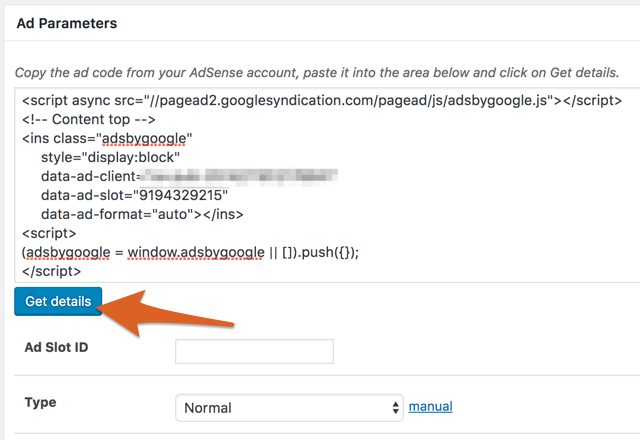
Go back to the Advanced Ads wizard and paste the code into the Ad Parameters box. Click the Get details button. Advanced Ads will automatically extract the Ad Slot ID and Publisher ID (which is saved to Advanced Ads → Settings → Adsense). Click Next to proceed to the next step in the wizard.
The Wizard will guide you to choose Display Conditions, Visitor Conditions and finally to Placements. Placements determine where the ad is displayed on your website. Free Advanced Ads users will get four ad placement options: Before Content, After Content, Post Content and Sidebar Widget. You’ll also get to make manual placement and add header/footer codes (handy for those who understand basic coding).
Tip: Despite the name, the Sidebar Widget placement is very flexible and can be used in any widget area. For example, you can display ads above the website header with a Before Header widget. There are additional placements with the free Genesis Ads add-on, available for Genesis themes.
For most beginners, Before Content or After Content is a good placement to start with. More placements are available in the Pro version. Select a placement and save it.
Done! You’ll be directed back to Ads Dashboard. Ads should start appearing on your website as soon as a few minutes up to a few hours, depending on your settings.
While you wait, I suggest you spend some time in Google AdSense’s Optimization Tips page and check out what they recommend as best practices. Also, don’t expect fast results. Google AdSense revenue may take time to trickle in.
Tip: The Wizard skips through some settings like Layout / Output, which allow you to add margin (spacing) around your ad. To get to these settings, navigate to Advanced Ads → Ads and edit the ad. Click Stop Wizard to display all settings for the ad.
Beyond Google AdSense
There are ways to ‘growth-hack’ and accelerate your blog earnings. One of them is by improving your website’s visibility in search engines. Yes, we’re talking about SEO – Search Engine Optimization. WordPress has a plugin for that, too – read the plain-English guide to Yoast SEO. Don’t let the jargons scare you, it’s actually pretty simple and easy to implement.
Google AdSense is not the only blog monetization strategy you can use. Aside from this, many people find using affiliate links and selling ad spaces profitable as well. Find out common blog optimization strategies and how to increase conversion rate in the next blog post!
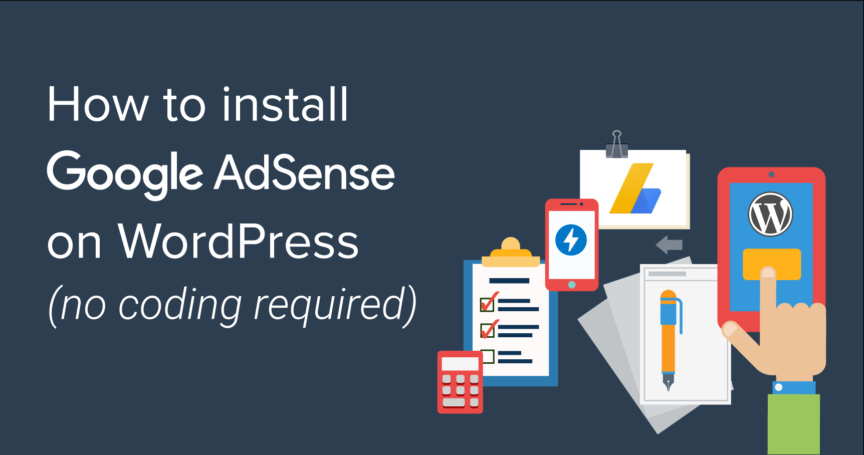


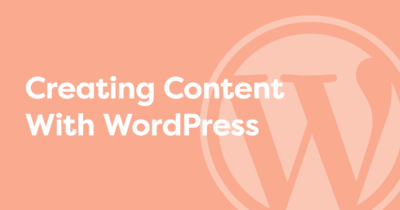
Thanks for sharing this informative article.
Do you think that SEO can play more of a factor in the earnings from Google Adsense than social media promotion of your site?
Kind regards,
Filip
Hello Admin
Thank you for the detail information about install Adsense on WordPress… I will definitely follow your method
Wohh precisely what I was searching for, thanks for posting.